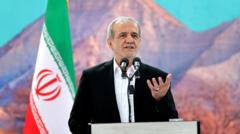Was Iran's President Injured in Israeli Strikes?

Understanding the Recent Escalation of Tensions Between Iran and Israel
The geopolitical landscape of the Middle East has been a hotbed of conflict for decades, with Iran and Israel consistently at odds. The recent escalation of hostilities has brought attention to the fragile balance of power in the region. One of the most alarming incidents occurred last month when Iranian President Masoud Pezeshkian was reportedly injured during an Israeli attack on a secret underground facility in Tehran. This incident raises significant questions about the motivations behind these military actions, the capabilities of both nations, and the potential consequences for regional stability.
The Incident: A Closer Look at the Attack
On June 16, a significant event unfolded that would further strain the already tense relationship between Iran and Israel. According to reports from Iran's state Fars news agency, which has close ties to the Revolutionary Guard, six bombs targeted a secret underground facility in Tehran. This facility was reportedly being used for an emergency meeting of the Supreme National Security Council, which is the highest decision-making body in Iran after the Supreme Leader, Ayatollah Ali Khamenei.
During the attack, President Pezeshkian sustained injuries to his leg as he and other officials attempted to escape through an emergency shaft. The assault was reportedly designed to block all entry and exit points, as well as the ventilation system of the facility, effectively trapping those inside. Electricity was cut off, heightening the danger for those present. Fortunately, Pezeshkian managed to reach safety, but the incident has raised alarms about the effectiveness of Iran's security measures and the intelligence capabilities of Israel.
The Aftermath: A Shift in Iranian Security Protocols
Following the attack, Iran's leadership has been on high alert. The government is reportedly pursuing leads regarding possible infiltration by Israeli agents. This heightened state of vigilance reflects the fear that Israel has developed sophisticated means of intelligence-gathering, allowing them to target high-ranking officials and critical facilities with precision.
In the wake of the attack, Pezeshkian publicly accused Israel of attempting to assassinate him, a claim that was promptly denied by Israeli Defense Minister Israel Katz. Katz asserted that "regime change" was not a goal of the current military operations. Nevertheless, the assertion by Iran's president underscores the increasing paranoia within Iranian leadership regarding their safety and the integrity of their operations.
The Broader Context: The 12-Day War
The incident involving President Pezeshkian did not occur in isolation. It was part of a larger conflict that erupted on June 13, when Israel launched a surprise offensive against Iranian nuclear and military sites. Israel's stated objective was to prevent Iran from developing nuclear weapons, an accusation that Tehran vehemently denies, asserting that its uranium enrichment is intended for peaceful purposes.
During the 12-day conflict, videos circulated on social media showing repeated strikes against mountainous areas in northwestern Tehran. These strikes were not random; they were calculated attacks aimed at critical infrastructure and leadership within Iran's military and political hierarchy. The extent of these operations caught Iranian officials off guard, leading to a state of paralysis for at least the first 24 hours post-attack, as they scrambled to assess the situation and formulate a response.
The Role of Intelligence in Modern Warfare
A key question arising from the recent events is how Israel was able to gather such precise intelligence about the movements and locations of Iran's top officials. The capabilities of intelligence agencies play a crucial role in modern warfare, and this incident highlights the importance of surveillance, reconnaissance, and data analysis in military strategy. Israel's advanced technology and intelligence-sharing arrangements with allies may have contributed to their successful targeting of Iranian leadership.
Moreover, the loss of many top commanders from Iran's Islamic Revolutionary Guard Corps (IRGC) at the onset of the conflict is another factor that has left the country reeling. The rapid elimination of key military figures not only disrupts command and control but also sends a message of vulnerability to both domestic and international audiences.
The International Implications of the Conflict
The repercussions of the ongoing conflict between Iran and Israel extend beyond their borders. The United States has been closely monitoring the situation, and on June 22, the U.S. Air Force and Navy conducted air and missile strikes against three Iranian nuclear facilities. President Donald Trump characterized these strikes as having "obliterated" the targeted sites, although some U.S. intelligence agencies have expressed caution about the long-term effectiveness of such military actions.
This involvement of the U.S. raises the stakes, as it signals a commitment to countering Iranian influence in the region. However, it also risks further entangling the United States in a conflict that could spiral into a larger war. The precarious nature of these alliances and the potential for miscalculation underscore the need for diplomatic efforts aimed at de-escalation.
The Stance of Global Powers
Global reactions to the conflict have varied significantly. Countries within the Middle East have watched the developments closely, with many fearing that the situation could destabilize the region further. Nations like Saudi Arabia and the United Arab Emirates, which have their own concerns about Iran's ambitions, may see an opening to bolster their own military capabilities or seek stronger alliances with Israel and the United States.
Conversely, countries sympathetic to Iran, such as Russia and China, may view the escalating conflict as an opportunity to increase their influence in the region. The dynamics of international relations in the Middle East are continually shifting, and the Iranian-Israeli conflict could become a focal point for broader geopolitical maneuvering.
Future Scenarios: What Lies Ahead?
The future of the Iran-Israel conflict remains uncertain. Several scenarios could unfold, ranging from continued military engagements to diplomatic negotiations aimed at de-escalation. Here are some potential outcomes:
- Increased Military Engagement: If both sides continue to escalate their military operations, the situation could spiral into a wider conflict involving regional actors and potentially global powers.
- Diplomatic Negotiations: There may be efforts from international bodies or regional powers to facilitate talks aimed at reducing tensions and establishing a ceasefire.
- Covert Operations: Both nations may resort to covert operations targeting each other's military infrastructure and leadership, resulting in a prolonged shadow war.
- Internal Strife in Iran: The loss of leadership and military commanders could lead to internal dissent within Iran, potentially destabilizing the regime and affecting its foreign policy.
Each of these scenarios carries significant implications for not only Iran and Israel but also for the broader geopolitical landscape. The choices made by leaders in the coming days and weeks will be critical in determining the direction of the conflict.
Conclusion: The Need for Vigilance and Diplomacy
The conflict between Iran and Israel is a complex issue rooted in historical grievances, ideological differences, and geopolitical ambitions. The recent attack that injured President Masoud Pezeshkian underscores the volatility of the situation and the potential for rapid escalation. As both nations navigate this treacherous landscape, the international community must remain vigilant and advocate for diplomatic solutions to prevent further loss of life and regional instability.
The question remains: will the leaders of Iran and Israel prioritize dialogue and peace, or will they continue down the path of confrontation?
FAQs
What was the outcome of the Israeli attack on the underground facility in Tehran?
The Israeli attack reportedly targeted an underground facility where Iranian leaders were meeting. President Masoud Pezeshkian sustained injuries, but managed to escape, highlighting the risks faced by Iranian leadership during the conflict.
What are the main reasons for the conflict between Iran and Israel?
The conflict is driven by ideological differences, territorial disputes, and concerns over Iran's nuclear program. Israel perceives Iran as a significant threat to its national security, while Iran views Israel's actions as aggressive and imperialistic.
How has the international community responded to the conflict?
The international response has been mixed, with some nations supporting Israel's actions as a means of preventing nuclear proliferation, while others criticize the military approach and advocate for diplomatic negotiations.
As tensions continue to mount, it is crucial for global leaders to engage in proactive diplomacy and seek constructive solutions to foster peace in the region. How will the unfolding events shape the future of Middle Eastern politics? #Iran #Israel #Geopolitics
Published: 2025-07-13 17:25:11 | Category: world



